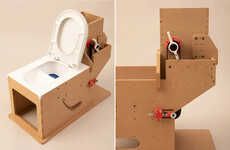All tree huggers need to take heed of the following innovation in farming and recycling. Peecycling is the act of recycling one’s urine for use as a local fertilizer.
Using pee for things other than just excrement isn’t a foreign concept. There are many tree huggers and non-tree huggers alike who drink urine for the nutrients and others in more desperate situations who even bathe in it, but peecycling is a whole new beat in pee re-appropriation. Peecyclists harvest discarded urine in big jugs and then use it to fertilize large plots of grass.
How good is urine as a fertilizer? Well after tests involving 60 participants in Vermont, it showed that the strip that was treated with urine shone greener. Urine contains nitrogen and phosphorous so this isn’t completely far fetched, just very unexpected.
Recycled Urine Plant Fertilization
Peecycling is the Latest in Tree-Hugging Innovations
Trend Themes
1. Urine Recycling - Disruptive innovation opportunity: Explore new ways to recycle urine as a sustainable and nutrient-rich fertilizer for various agricultural practices.
2. Sustainable Agriculture - Disruptive innovation opportunity: Develop alternative methods of fertilization, such as using organic waste products or reusing waste materials, to promote eco-friendly farming.
3. Circular Economy - Disruptive innovation opportunity: Implement urine collection and reuse systems to close the nutrient loop and reduce waste, contributing to a more sustainable and circular economy.
Industry Implications
1. Agriculture - Disruptive innovation opportunity: Integrate urine recycling techniques into traditional farming practices to enhance yields while minimizing environmental impact.
2. Waste Management - Disruptive innovation opportunity: Create urine collection and processing technologies to effectively manage and repurpose human waste, reducing the strain on traditional sewage systems.
3. Environmental Sustainability - Disruptive innovation opportunity: Develop innovative solutions that leverage urine recycling to promote sustainable resource management and reduce reliance on conventional fertilizers.




